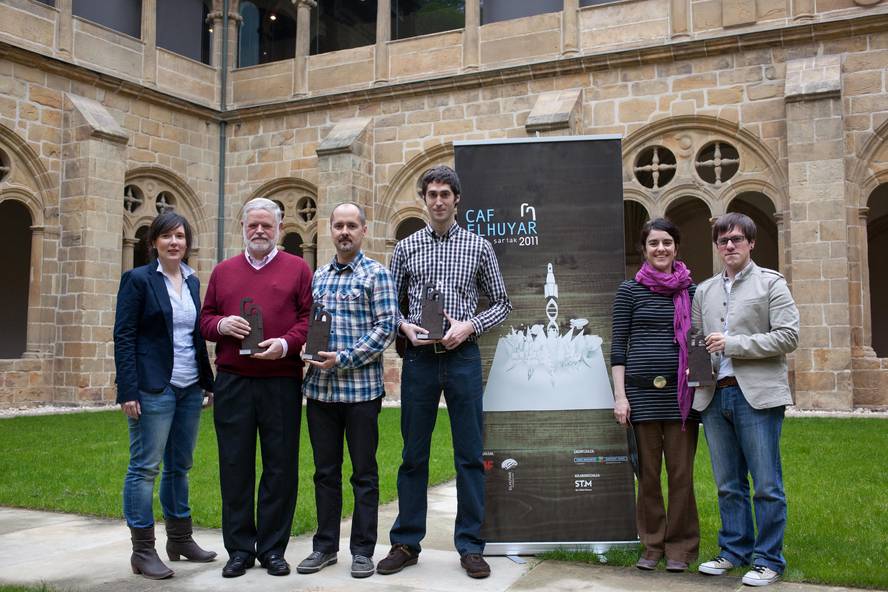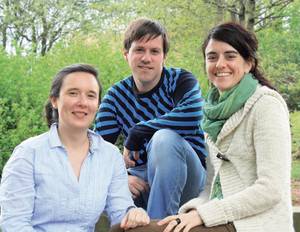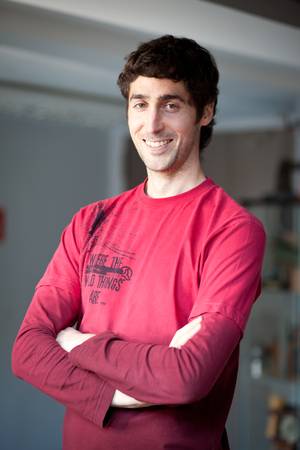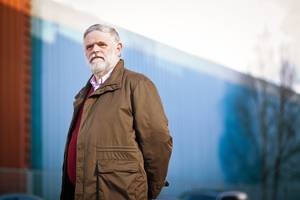The San Telmo Museum hosts today the CAF-Elhuyar awards ceremony

The San Telmo Museum of San Sebastian has celebrated the CAF-Elhuyar 2011 awards ceremony. In the church, the dantzaris of the Kukai company have begun the act, through dance they have wanted to be faster than the pen and face gravity. The white page has been the metaphor for this year's edition and the challenges have been the focus. The challenges of society, the responses of science and technology and, again, the new challenges created by science and technology. Mixed with the multimedia and live show, the dantzaris, scientists, staff of the Elhuyar Foundation and attendees have offered the first minutes of the event to reflection, under the direction of Oihana Jauregi.
“Show what you can do with a blank page” has been the motto of the 2011 CAF-Elhuyar Awards, and today’s event has been awarded the best of the daring: Patricia Navarro, Alfredo Sarmiento and Jone Omar, chemists of the UPV; Jon Makibar, engineer and researcher of IK4-Ikerlan; Gorka Zabaleta, journalist of the magazine Baleike; and Jose Mari Elortza, professor of the Faculty of Chemistry of the UPV.
General Disclosure Article

Patricia Navarro, Alfredo Sarmiento and Jone Omar have titled “The Art of Chemistry and the Chemistry of Art” in the article given by chemists from the Department of Analytical Chemistry of the UPV. According to the jury, “although classical, it is a well structured work, with good starting point and that the authors perfectly defend the thesis of the article”.
In fact, it is an exercise to combat chemophobia that is considered widespread in society: “Today’s society has a certain fear of everything related to chemistry,” they stress, “there are ecological and “bio” products today, and we hear a lot that chemicals affect cancer and other diseases. But, really, everything is chemical.”
To defend the ubiquity of chemistry, the three authors take a tour of the history of art, emphasizing the role that chemistry has played in each epoch. One of the areas of work of the authors' research team is the analysis of heritage, so this article has been a way to combine their work with disclosure.
Dissemination article based on the author's doctoral thesis

Eibarrés engineer Jon Makibar has combined his research work with outreach and has received the award for the dissemination article based on the author’s doctoral thesis for his article “Pyrolysis and biorefineries”.
Makibar has completed his thesis at the University of the Basque Country and Ikerlan. The objective has been to develop a process of energy transformation of waste from the biomass sector, which has consisted in the taking of a research reactor designed at the university and its transfer to the scale of a pilot pyrolysis plant.
Makibar recognized the difficulty of writing the article: “After writing the thesis in a very technical Basque, you have to write in another Basque that anyone understands. You have to teach the result to your girlfriend or brother to ask if it is understood or not. And if they say “it’s a bit hard to understand,” you have to change it. There have been four or five drafts.”
Despite the difficulty of transferring the doctoral thesis to an informative level, this year more papers have been presented than ever in this category, and the members of the jury have pointed out that they have had more difficulties than ever to decide who to award the prize. The jury has particularly appreciated the works of this category in terms of content and form. “It is a satisfaction and a congratulation to see that the thesis is increasingly focused on researchers trained to communicate in Basque,” said candidate Itziar Alkorta.
Work in Scientific Journalism
_display.jpg)
In addition to the category of outreach articles, the CAF-Elhuyar Awards also award scientific journalism. And in the 2011 edition Zumaiarra journalist Gorka Zabaleta has been the best, “Itsas hondoa eskura. A world that does not appear on maps.”
The jury highlighted on this work “the direct style of the journalist, the extensive documentation, the ability to gather different points of view, the beautiful graphics used and his ability to relate to the present”, and with it, “the author’s effort to combine local issues with science”.
According to Zabaleta, the idea of reporting comes from the effort to bring together local science and topics. “Knowing the map of AZTI,” he says, “the first idea was that we had to get it, at least the part corresponding to Zumaia. But then we thought that, pulling other threads, we could give a wider reading to the report. So far we have not had that precision of the seabed, but we live on the coast and people have moved in the sea, worked in the sea, benefited from the sea. It occurred to us to compare the knowledge accumulated over centuries with the map made by AZTI.”
The report is available on the Baleike magazine website.
Elhuyar Award of Merit

To conclude the event, the chemist and professor of the UPV/EHU Jose Mari Elortza has received the Merit Award 2011. José Mari Rodríguez Ibabe, president of the Elhuyar Foundation, has received the award.
With the creation of Bergarés, Elortza studied chemistry at the University of Valladolid and joined the Faculty of Chemistry of San Sebastian in 1976. At that time he began writing chemistry textbooks in Basque. His writings are books on Macromolecular Physical Chemistry and Thermodynamics used by many generations of students.
With José Ramón Etxeberria, 2010 meritorium, and Jazinto Iturbe and others, Elortza pioneered the production of texts for teaching in Basque. Although pioneers had to do “the impossible with action,” Elorza has no feeling of having done laborious work. “It was a nice job,” he says.
Elorza recalls the initial difficulties: “Imagine, when we started, the problem of writing science was the reference we had to take. We only knew two books, both written before the Spanish war, in 1936: Quimia and Pisia by Jauregitar Gabriel. At the Faculty of Chemistry we gathered together some students and I,” he continues, “and we decided how he would say things in the Faculty. We also contacted those in Leioa, with whom we closed the situation and then at the Basque Summer University. We spent a lot of time deciding and often no decision was made, but they talked about it.”
However, Elorza believes that the difficulties had been overcome long ago. “For more than 20 years, perhaps,” he says, “I have not felt any difficulty in teaching the subject in Basque and explaining what needs to be explained.”
Jobs and juries
The CAF-Elhuyar Awards 2011 presented a total of 48 works: 23 in the category of general disclosure articles, 14 in the category of articles based on the author's thesis, 9 in the category of scientific journalism works and 2 in the category of scientific narratives aimed at young people. The jury has left behind the prize of scientific narratives for young people.
The jury of the 2011 edition of the CAF-Elhuyar Awards has been composed of eight people:
- Yolanda Arrieta, writer and expert in children's and youth literature
- Jesus Mari Olaizola "Txiliku", writer and expert in children's and youth literature
- Itziar Alkorta, professor of civil law and bioethics
- José María Pitarke, director of CIC NanoGUNE
- Juan Ignacio Pérez Iglesias, Director of the Chair of Scientific Culture of the UPV-DFB
- Txema Ramírez de la Piscina, professor at the UPV Faculty of Journalism and expert in specialized journalism
- Josu Waliño, project manager at the Elhuyar Foundation and storyteller for young people;
- Jose Mari Rodriguez Ibabe, president of the Elhuyar Foundation and CEIT researcher.





